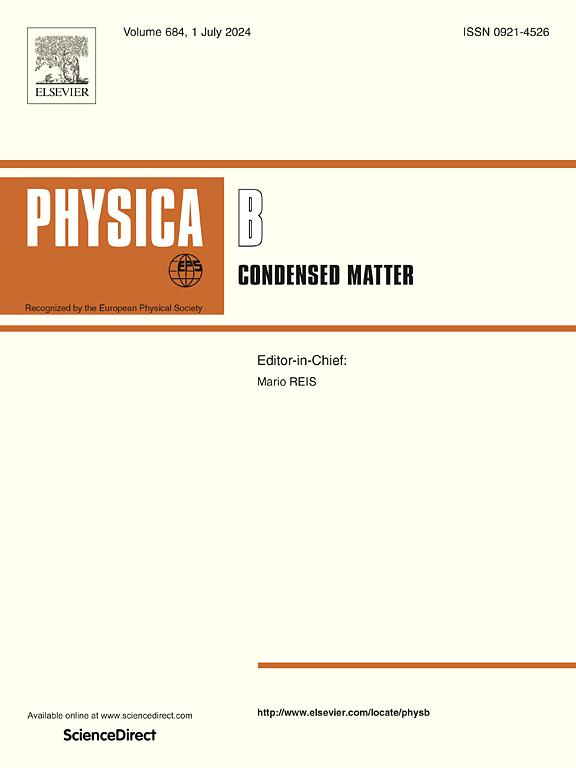Graphene nanoribbon resonant tunneling diode with dual connection between contacts
IF 2.8
3区 物理与天体物理
Q2 PHYSICS, CONDENSED MATTER
引用次数: 0
Abstract
In this paper, we numerically study the transport properties of a resonant tunneling diode (RTD) based on graphene nanoribbon (GNR) with an H-type antidote between the contacts. The structure may also be thought of as having two parallel (W-shape) parts connecting the contacts, each having a wider channel region sandwiched between two narrower barrier regions. The energy at which quasi-bound states occur in each part depends on the dimensional parameters of the respective portion in the structure. We study how the transmission through quasi-bound states is influenced by the edge states on the contacts and dimensional parameters such as barrier length and also by the ambient temperature. The results are compared with those of an RTD with a single part connecting the contacts. Transmission peaks at different energies are observed for an RTD with asymmetrical lower and upper parts between the contacts. This is then utilized for the creation of two negative differential resistance (NDR) peaks. For numerical computation, the non-equilibrium Green’s function formalism (NEGF) based on the nearest neighbor tight-binding model is employed.
触点间双连接的石墨烯纳米带谐振隧道二极管
本文对基于石墨烯纳米带(GNR)的共振隧穿二极管(RTD)的传输特性进行了数值研究,该器件的触点之间具有 H 型解毒剂。这种结构也可以看作是连接触点的两个平行(W 形)部分,每个部分都有一个较宽的通道区,夹在两个较窄的阻挡区之间。每个部分出现准束缚态的能量取决于结构中相应部分的尺寸参数。我们研究了通过准结合态的传输如何受到触点边缘状态和尺寸参数(如势垒长度)以及环境温度的影响。我们将研究结果与单部分连接触点的热电阻进行了比较。对于触点之间上下部分不对称的热电阻,可以观察到不同能量下的传输峰值。然后利用这一点创建了两个负微分电阻 (NDR) 峰值。在数值计算中,采用了基于近邻紧密结合模型的非平衡格林函数形式主义(NEGF)。
本文章由计算机程序翻译,如有差异,请以英文原文为准。
求助全文
约1分钟内获得全文
求助全文
来源期刊

Physica B-condensed Matter
物理-物理:凝聚态物理
CiteScore
4.90
自引率
7.10%
发文量
703
审稿时长
44 days
期刊介绍:
Physica B: Condensed Matter comprises all condensed matter and material physics that involve theoretical, computational and experimental work.
Papers should contain further developments and a proper discussion on the physics of experimental or theoretical results in one of the following areas:
-Magnetism
-Materials physics
-Nanostructures and nanomaterials
-Optics and optical materials
-Quantum materials
-Semiconductors
-Strongly correlated systems
-Superconductivity
-Surfaces and interfaces
 求助内容:
求助内容: 应助结果提醒方式:
应助结果提醒方式:


